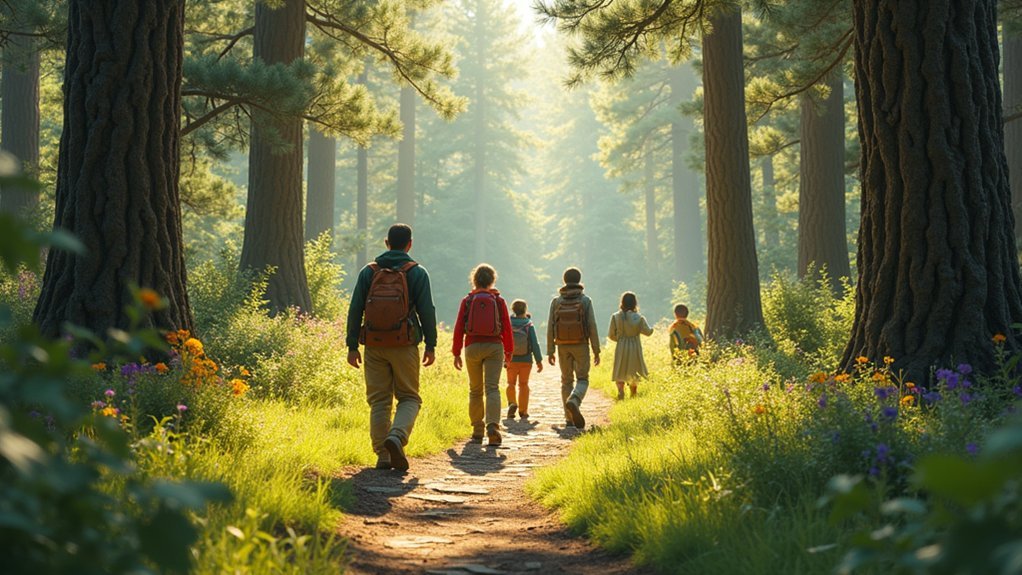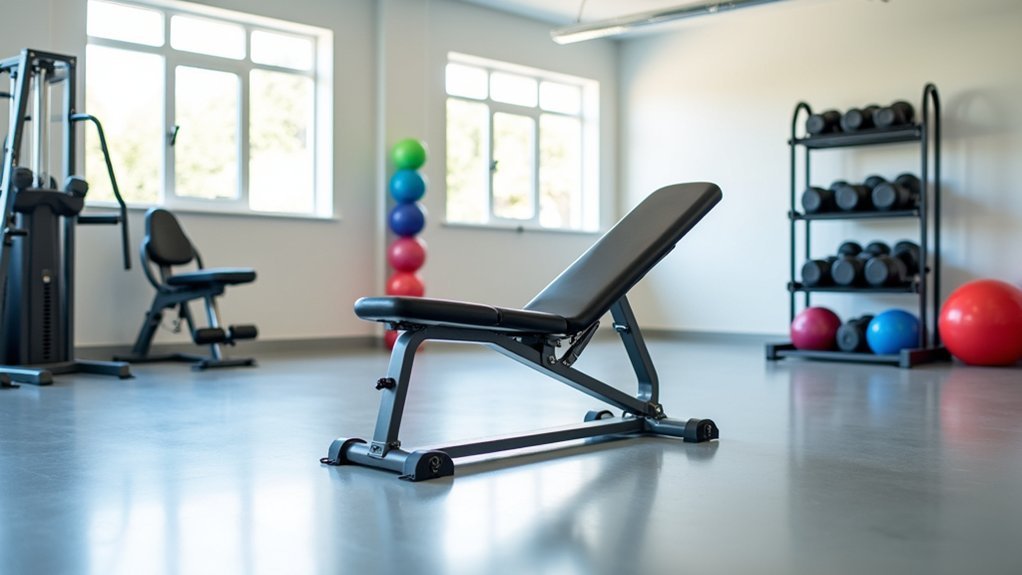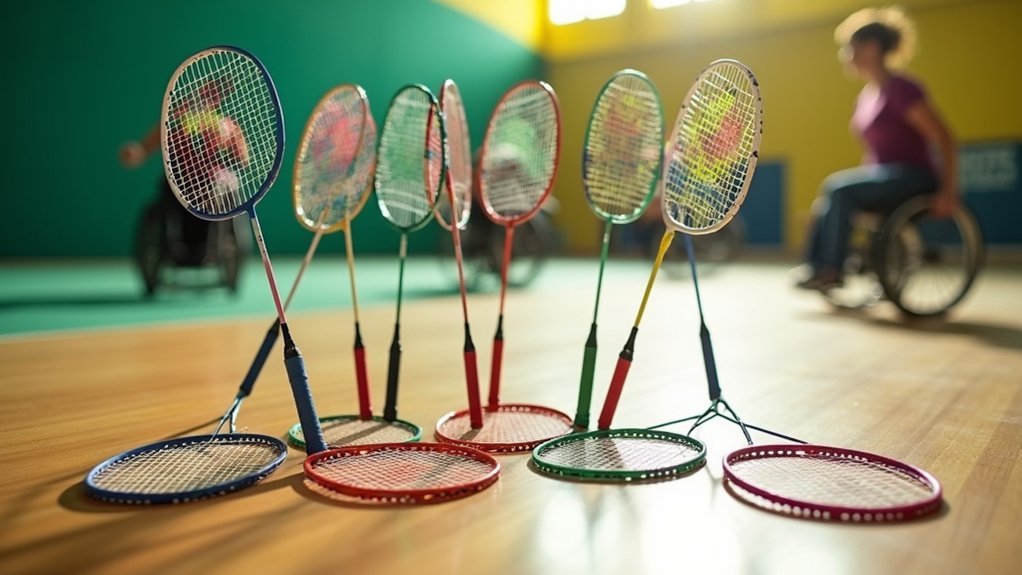Specialized nature tours for visually impaired explorers offer rich sensory experiences through touch, sound, and smell. You’ll find guided trails with textured surfaces, tactile maps, and trained professionals who provide vivid verbal descriptions. Modern adaptive equipment like GPS devices with audio feedback can enhance your wilderness navigation. Year-round opportunities include winter ice fishing and summer sensory gardens. These accessible adventures not only connect you with nature but also offer therapeutic benefits and foster community among fellow explorers.
Sensory-Rich Trails: Experiencing Nature Beyond Sight

While vision often dominates our experience of nature, sensory-rich trails open up an entirely new world for visually impaired explorers. These specially designed pathways incorporate textured surfaces that guide you through the landscape, allowing you to navigate independently while connecting with the environment.
As you explore these accessible travel routes, you’ll encounter tactile elements like bark textures, smooth stones, and carefully placed natural features that tell the story of the ecosystem through touch.
The sensory-rich trails encourage you to engage with nature using your remaining senses—feeling the gentle breeze, smelling fragrant flowers, and listening to rustling leaves or flowing water. Your fingers become your eyes, reading the natural landscape through its varied textures and dimensions, creating a rich, multisensory adventure that rivals any visual experience.
Adaptive Equipment for Wilderness Exploration
Because traversing the wilderness presents unique challenges, specially designed adaptive equipment has revolutionized outdoor exploration for visually impaired adventurers.
You’ll find GPS devices with audio feedback indispensable for staying on course while hiking remote trails. These navigation tools work alongside tactile maps with raised surfaces that help you understand the terrain before venturing out.
When exploring the world beyond city limits, specialized canes with wider tips detect obstacles and terrain changes more effectively than standard models.
You’ll appreciate hiking backpacks designed with dedicated compartments for your assistive devices and sound-emitting safety beacons.
For enhanced environmental awareness, consider wearable technology like smart glasses that provide real-time audio descriptions of your surroundings, connecting you more deeply with nature’s wonders.
Guide Techniques for Enhanced Nature Descriptions

Skilled tour guides transform invisible landscapes into rich sensory experiences through thoughtfully crafted descriptions.
The best sighted guides paint vivid verbal pictures, detailing how sunlight filters through autumn leaves or how mist clings to mountain valleys. They’ll invite you to touch the rough bark of an ancient oak or feel the silky texture of moss growing on river rocks.
Immerse yourself in nature’s textures—from dappled light dancing through leaves to your fingertips discovering moss-covered stones along forest streams.
Listen for guides who excel at audio descriptions—capturing the distant call of hawks, the rhythmic patterns of rainfall, or the rustling of wildlife in underbrush.
One of the most valuable travel tips: seek guides who encourage you to share your own perceptions, creating a two-way exploration.
Many now complement their narration with specialized apps that identify bird calls or plant species, further enriching your connection to the natural world.
Therapeutic Benefits of Natural Environments
The healing power of natural settings extends far beyond their beauty for visually impaired travelers. When you’re immersed in nature, you’ll experience significant reductions in stress, anxiety, and depression—benefits that are particularly valuable for a blind person maneuvering daily challenges.
Research shows spending time outdoors can cut negative thoughts by 71% while enhancing your mood and promoting relaxation. You’ll also enjoy improved cognitive function, with problem-solving abilities increasing by up to 50% after nature experiences.
Natural environments offer rich sensory engagement through touch, smell, and sound—creating meaningful connections without relying on sight.
Additionally, participating in guided nature walks provides valuable social interaction and community building, amplifying the therapeutic benefits of outdoor experiences and supporting your overall mental wellbeing.
Community-Based Nature Excursions for Visually Impaired Groups

You’ll find local sensory tours tailored for visually impaired participants emphasize touch, sound, and smell experiences that transform natural spaces into accessible adventures.
These community excursions often feature trained guides who provide detailed audio descriptions while encouraging hands-on exploration of plant textures, soil composition, and natural artifacts.
Guided wilderness connections create opportunities for shared discovery, where you’ll join others with similar experiences to navigate forests, coastal trails, or botanical gardens through specially designed sensory pathways.
Local Sensory Tours
While traditional nature excursions rely heavily on visual elements, local sensory tours transform this paradigm by creating immersive outdoor experiences specifically designed for visually impaired participants. These specialized journeys invite you to connect with nature through your remaining senses—feeling the texture of bark, smelling wild herbs, and hearing the symphony of wildlife.
| Sensory Element | Experience Offered |
|---|---|
| Touch | Tactile exploration of plants, soils, and natural textures |
| Sound | Guided listening to identify birds, water features, and forest sounds |
| Smell | Aromatic interactions with local flora and seasonal scents |
With a knowledgeable travel companion guiding you through accessible natural settings, you’ll discover local cultural elements while forming meaningful connections with fellow participants. These community-based experiences foster both environmental appreciation and valuable social bonds.
Guided Wilderness Connections
Community-based nature excursions provide visually impaired adventurers with unprecedented access to wilderness experiences through carefully orchestrated group journeys.
These specialized travel opportunities feature guides trained specifically for visually impaired participants who facilitate rich sensory connections with nature.
You’ll discover landscapes through touch, sound, and scent while traversing trails designed with your safety and mobility needs in mind.
Each expedition incorporates tactile exploration of local flora and fauna, complemented by detailed auditory descriptions that deepen your understanding of the environment.
Beyond wilderness immersion, these excursions foster valuable social connections.
You’ll meet fellow explorers who share similar experiences, building friendships that often extend beyond the trail.
These community bonds become as meaningful as the natural discoveries you’ll make together.
Seasonal Opportunities: Year-Round Accessible Outdoor Adventures
You’ll find exciting winter adventure options including guided snowshoeing treks and adaptive skiing programs that pair you with trained guides for safe, exhilarating cold-weather experiences.
Summer transforms accessibility with sensory-rich kayaking expeditions where you can feel the gentle spray of water and hear wildlife in their natural habitats.
These year-round opportunities guarantee your connection with nature remains unbroken regardless of season, with each activity specifically adapted to enhance your unique way of experiencing the outdoor world.
Winter Adventure Options
When snow blankets the landscape, a whole new world of sensory exploration opens up for visually impaired adventurers.
With specialized equipment and trained professionals, winter activities become accessible even for those with Low Vision. A sighted guide can help navigate snowy terrain while describing the pristine surroundings.
- Feel the gentle crunch of snow beneath your snowshoes as you traverse quiet forest paths
- Experience the exhilaration of adaptive skiing, with the wind against your face and verbal guidance from your instructor
- Discover wildlife tracks with your fingertips, learning to identify animals by the impressions they leave behind
- Listen to the delicate crack of ice during guided fishing expeditions on frozen lakes
- Touch intricate ice sculptures at winter festivals designed with tactile exploration in mind
Summer Sensory Experiences
As the warm season unfolds, summer offers an abundance of rich sensory experiences for visually impaired explorers.
You’ll discover specially designed sensory gardens featuring fragrant plants and textured surfaces that engage your touch and smell senses while sighted guides provide detailed descriptions of the surroundings.
Participate in guided nature walks where you can identify wildlife through sounds and tactile experiences rather than visual cues. These summer sensory experiences often incorporate trained professionals who highlight seasonal changes through auditory and tactile elements you might otherwise miss.
Community events in natural settings also create opportunities for social connections with fellow explorers.
Many organizations provide year-round adventures, but summer’s unique offerings—like tactile gardening and sensory-friendly hikes—create unforgettable outdoor experiences that don’t rely on vision to appreciate nature’s beauty.
Frequently Asked Questions
Is There a Navigation System for Blind People?
Yes, you’ll find several navigation systems for blind people including GPS apps with audio feedback, wearables like Sunu Band with haptic feedback, and services like Aira that connect you with sighted guides.
How Do Blind People Navigate Outdoors?
You’ll find blind people navigate outdoors using white canes, guide dogs, echolocation techniques, GPS apps with audio guidance, and sometimes with companions. They rely on touch, hearing, and technology for independence.
Where to Take a Blind Person for Fun?
You’ll find botanical gardens with sensory trails, wildlife tours, national parks with audio-described hikes, adventure activities like kayaking, and sensory-friendly events perfect for blind individuals. They’ll enjoy these immersive, multi-sensory experiences.
What Country Is Best for Blind People?
The best country for blind people is Sweden, with its thorough accessibility standards. You’ll appreciate Canada and the UK’s specialized tours, while Australia and New Zealand offer excellent inclusive tourism programs for visually impaired travelers.
In Summary
You’ve discovered that nature isn’t limited to those who can see its beauty. Through sensory-rich experiences, adaptive tools, and skilled guides, you’re now empowered to explore the natural world on your terms. As you continue your journey, remember that wilderness adventures offer both therapeutic benefits and community connections. Don’t wait—embrace the changing seasons and discover the countless accessible outdoor experiences awaiting your exploration.





Leave a Reply